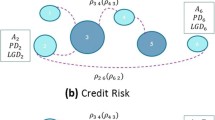Abstract
The importance of adequately modeling credit risk has once again been highlighted in the recent financial crisis. Defaults tend to cluster around times of economic stress due to poor macro-economic conditions, but also by directly triggering each other through contagion. Although credit default swaps have radically altered the dynamics of contagion for more than a decade, models quantifying their impact on systemic risk are still missing. Here, we examine contagion through credit default swaps in a stylized economic network of corporates and financial institutions. We analyse such a system using a stochastic setting, which allows us to exploit limit theorems to exactly solve the contagion dynamics for the entire system. Our analysis shows that, by creating additional contagion channels, CDS can actually lead to greater instability of the entire network in times of economic stress. This is particularly pronounced when CDS are used by banks to expand their loan books (arguing that CDS would offload the additional risks from their balance sheets). Thus, even with complete hedging through CDS, a significant loan book expansion can lead to considerably enhanced probabilities for the occurrence of very large losses and very high default rates in the system. Our approach adds a new dimension to research on credit contagion, and could feed into a rational underpinning of an improved regulatory framework for credit derivatives.
Similar content being viewed by others
References
A.G. Haldane, Rethinking the Financial Network (2009), www.bankofengland.co.uk/publications/speeches/2009/speech386.pdf
A. Turner, A. Haldane, P. Woolley, S. Wadhwani, A. Smithers, A. Large, J. Kay, M. Wolf. The Future of Finance, The LSE Report, LSE, 2010
ECB, Credit Default Swaps and Counterparty Risk (2009), http://www.ecb.int/pub/pdf/other/creditdefaultswapsandcounterpartyrisk2009en.pdf
A.G. Haldane, R.M. May, Nature 469, 351 (2011)
D. Lando, Review of Derivatives Research 2, 99 (1998)
D. Duffie, K. Singleton, Rev. Financ. Stud. 12, 197 (1999)
M. Davis, V. Lo, Quant. Financ. 1, 111 (1999)
R. Jarrow, S. Turnbull, J. Financ. 56, 1765 (2001)
D. Li, J. Fixed Inc. 9, 43 (2001)
R. Frey, J. Backhaus, Interacting Defaults and Counterparty Risk: a Markovian Approach, Working Paper, University of Leipzig, 2003
E. Rogge, P.J. Schönbucher, Modelling Dynamic Portfolio Credit Risk, Working Paper, Imperial College, London, ABN Amro Bank, London, and ETH, Zürich, 2003
K. Giesecke, S. Weber, J. Bank. Financ. 28, 3009 (2004)
P. Neu, R. Kühn, Physica A 342, 639 (2004)
J.P.L. Hatchett, R. Kühn, J. Phys. A 39, 2231 (2006)
D. Egloff, M. Leippold, P. Vannini, J. Bank. Financ. 31, 2475 (2007)
J.P.L. Hatchett, R. Kühn, Quant. Financ. 9, 373 (2009)
S. Keenan, Historical Default Rates of Corporate Bond Issuers, 1920-1999 (Moody’s Investor Services, 2000)
S.R. Das, D. Duffie, N. Kapdia, L. Saita, J. Financ. 62, 93 (2007)
D. Duffie, A. Eckner, G. Horel, L. Saita, J. Financ. 64, 2089 (2009)
S. Azizpour, K. Giesecke, G. Schwenkler, Exploring the Sources of Default Clustering, 2011, http://www.stanford.edu/dept/MSandE/cgi-bin/people/faculty/giesecke/pdfs/exploring.pdf
J. Hull, A. White, J. Derivatives 8, 29 (2000)
J. Hull, A. White, J. Derivatives 8, 12 (2001)
H. Haworth, C. Reisinger, J. Cred. Risk 3, 31 (2007)
H. Haworth, C. Reisinger, W. Shaw, Quant. Financ. 8, 669 (2008)
E. Errais, K. Giesecke, L. Goldberg, SIAM Journal on Financial Mathematics 1, 642 (2010)
R. Frey, J. Backhaus, Int. J. Theor. Appl. Financ. 11, 611 (2008)
D. Brigo, K. Chourdakis, Int. J. Theor. Appl. Financ. 12, 1007 (2009)
R. Frey, J. Backhaus, J. Econ. Dyn. Contr. 34, 710 (2010)
A. Cousin, M. Jeanblanc, J.-P. Laurent, Hedging CDO Tranches in a Markovian Environment, in Paris-Princeton Lectures on Mathematical Finance 2010, edited by R.A. Carmona, E. Cinlar, I. Ekeland, E. Jouini (Springer, Berlin, Heidelberg, 2011), pp. 1–62
P. Jorion, G. Zhang, J. Financ. Econ. 84, 860 (2007)
S. Markose, S. Giansante, M. Gatkowski, A.R. Shaghaghi, Too Interconnected To Fail: Financial Contagion and Systemic Risk In Network Model of CDS and Other Credit Enhancement Obligations of US Banks, Presentation given at the ECB Workshop on Recent Advances in Modelling Systemic Risk Using network, October 2009, COMISEF Working Papers Series WPS-033 21/04/2010, 2010
H. Elsinger, A. Lehar, M. Summer, Manage. Sci. 52, 1301 (2006)
F. Schweitzer, G. Fagiolo, D. Sornette, F. Vega-Redondo, A. Vespignani, D.R. White, Science 325, 422 (2009)
R. Cont, E. Bastos e Santos, A. Moussa, Network Structure and Systemic Risk in Banking Systems, working paper, SSRN-1733528, 2009
P. Gai an S. Kapadia, Proc. R. Soc. A 466, 2401 (2010)
H. Amini, R. Cont, A. Minca, Int. J. Theor. Appl. Financ. 15, 125006 (2012)
F. Caccioli, P. Vivo, M. Marsili, Eur. Phys. J. B 71, 467 (2009)
ISDA, ISDA Market Survey Annual Data (2010), http://www2.isda.org/functional-areas/research/surveys/market-surveys/
B. Derrida, E. Gardner, A. Zippelius, Europhys. Lett. 4, 167 (1987)
C. De Dominicis, Phys. Rev. B 18, 4913 (1978)
B. Bollobàs, Random Graphs (Cambridge University Press, Cambridge, 2001)
Basel Committee on Banking Supervision, International Convergence of Capital Measurement and Capital Standards: A Revised Framework. Credit Risk – The Internal Ratings Based Approach (2005), Part 2, Sect. III, www.bis.org
R.M. May, Nature 238, 413 (1972)
J.P.L. Hatchett, B. Wemmenhove, I. Pérez Castillo, T. Nikoletopoulos, N.S. Skantzos, A.C.C. Coolen, J. Phys. A 37, 6201 (2004)
Author information
Authors and Affiliations
Corresponding author
Rights and permissions
About this article
Cite this article
Heise, S., Kühn, R. Derivatives and credit contagion in interconnected networks. Eur. Phys. J. B 85, 115 (2012). https://doi.org/10.1140/epjb/e2012-20740-0
Received:
Revised:
Published:
DOI: https://doi.org/10.1140/epjb/e2012-20740-0




